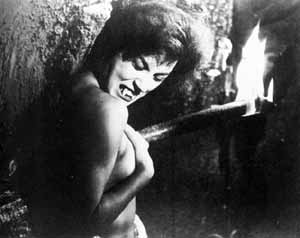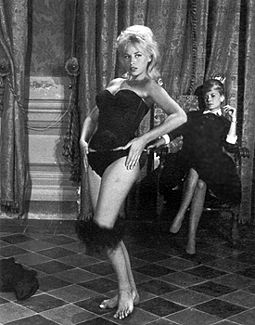DVD review by Gary Johnson Throughout the better part of the '40s and '50s, few horror films were produced. Audiences were more interested in giant bugs and flying saucers than they were in vampires and brutes assembled from disinterred body parts. But after Hammer Films mixed a little sex with a little blood in their retellings of the Dracula and Frankenstein stories, the world of horror cinema changed forever. The effects were particularly profound in Italy, where vampire movies had never done big business. But in 1958 when Christopher Lee donned a cape and fangs and Peter Cushing brandished a crucifix and wooden stake in Hammer Films' Dracula (American title: Horror of Dracula), audiences flocked to theaters. Italian producers soon began contemplating their own tales of vampires. Italian filmmaker Riccardo Freda had actually beaten Hammer's Dracula into theaters with his own I Vampiri (American title: The Devil's Commandment), released in 1956. But Italian audiences stayed away. While I Vampiri is now regarded as a classic of Italian gothic horror, it had little initial impact. In 1960, Mario Bava's Black Sunday set the standard for subsequent Italian horror films with its atmospheric compositions and shocking images, but not all Italian filmmakers were as interested in the artistic use of light and shadow as Bava. Some Italian filmmakers chose a cruder approach that eschewed atmosphere in favor of liberal doses of nudity and sex. The Playgirls and the Vampire is one of the first of these films. Filmed in 1960 by Piero Regnoli (who co-scripted I Vampiri), The Playgirls and the Vampire contains one of the most often repeated plots of horror cinema: when a group of travelers becomes stranded at a castle, the travelers quickly come under attack by a vampire. In this case, however, the story is enlivened by two additions: 1) the travelers are a troupe of showgirls/strippers who practice their trade for the benefit of the movie's audience and 2) after one of the showgirls is vampirized, she sprouts fangs the size of tent pegs and stalks the castle hallways while bucknaked.
Admittedly, these additions do indeed lend the film a certain campy charm. Once inside the castle, one of the girls spies the large dinning table and says, "I wonder if they'll let me do my high kick specialty on it?" These playgirls love to practice their routines. While watching one of the troupe members bump and grind her way through a particularly hot number, the girls and their male manager are all grins. They use stripping as a way to cheer up after one of the girls has been killed and buried: "The girls have been very upset, as you know, and this was the only way to make them stop worrying about it," says their manager when the castle's housekeeper interrupts the striptease. While the showgirls contribute to the movie's absurd atmosphere, the presence of Maria Giovannini as a naked vampire is startling. When she first appears, only her face is illuminated, but when she steps from the shadows, we find she's as naked as a jay bird. She steps forward with her shoulders hunched. She's prowling. She comes directly at the camera, as if we're her prey. It's a surprising and jarring moment in an otherwise silly movie, a moment that no doubt had a strong influence on French director Jean Rollin who later in the same decade began creating his own series of sexy vampire movies.
Regnoli's camera does provide occasional flourishes. In the opening moments, he provides a short, moody stroll through a crypt as light slants through a window and a tomb lid begins to move. And later he provides a wonderfully expressionistic moment as a vampire's hand claws its way around the corner of a stone wall. However, most interiors are too brightly lit and look as if they were slapped together from plywood and plaster. Rooms are separated from the main hallway by curtains instead of doors. But on occasion, the phony sets suddenly disappear and suddenly we're in a genuinely creepy location. For example, after the castle's owner, Count Gabor Kernassy, warns the visitors to stay in their rooms at night, one of the girls, Katya (Giovannini), wanders through the halls. At first, her stroll is about as eerie as a church group's haunted house, but suddenly we're in a real castle, with real stone walls and rickety steps that lead nowhere. The effect is unnerving. Walter Brandi assumes a double role as the Count Kernassy and as his twin ancestor, a 200-year-old vampire. Brandi starred in several Italian horror movies, including Slaughter of the Vampires and Bloody Pit of Horror, but unfortunately he was a wooden actor with little screen presence. In The Playgirls and the Vampire, he steps forward stiffly and does most of his acting with overemphatic eye movements. Acquired for U.S. distribution by Richard Gordon in 1964, L'Ultima Preda del Vampiro (English translation: "The Last Prey of the Vampire") was quickly rechristened The Playgirls and the Vampire and released as an "adults only" feature. Later, it was re-edited for television as The Curse of the Vampire. This new DVD release from Image Entertainment contains the original American theatrical version. This means the fleeting nudity is intact, as is the striptease by Erika Di Centra; however, this print also contains the dreadful dubbing that Richard Gordon commissioned for the film's original release. The original Italian soundtrack and subtitles would have been a welcome addition to this DVD package, but it's probably a bit presumptuous to suggest that such care be given to one of Italy's most ludicrous gothic horror movies.
The Playgirls and the Vampire is now available on DVD from Image Entertainment. Suggested retail price: $24.98. The DVD contains no extras; however, Tim Lucas of Video Watchdog provides the liner notes. For additional information, we suggest you check out the Image Entertainment Web site.
|


